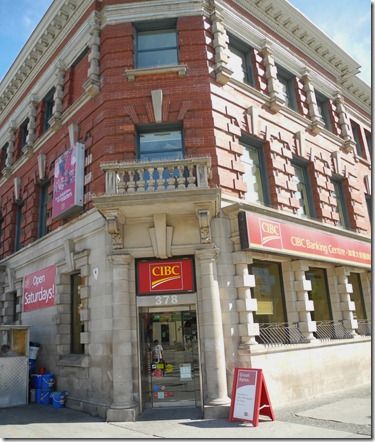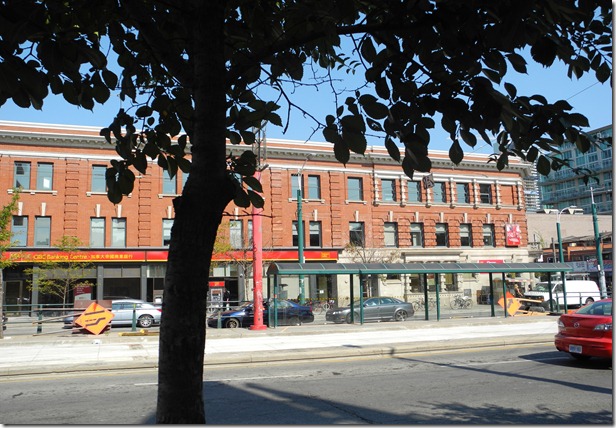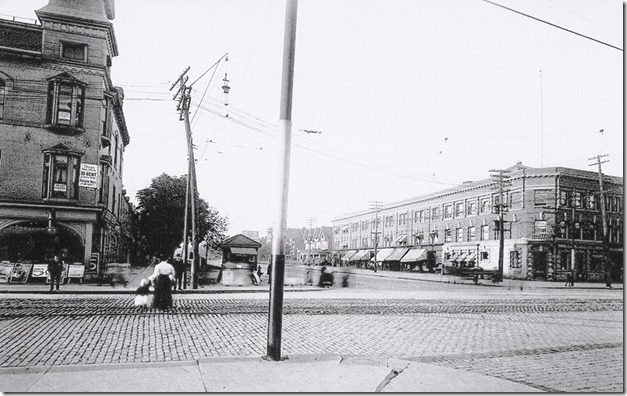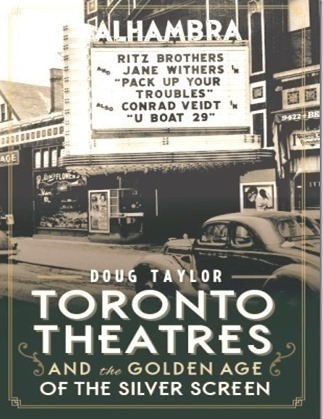378 Queen Street West (the bank building at the northeast corner of Spadina and Queen Streets)
During the early 1840s, on the site of the bank building was a modest wood-frame house, which was later converted into a small hotel. In 1856 its proprietor was Henry McEvoy, who operated a tavern and grocery business. In 1864 John Clark became the tavern-keeper. Throughout the years it changed ownership several more times At one time it was named Brown’s Hotel; then it became Brewer’s Hotel. It became the Avenue Hotel in 1880, but it remained under the management of Mr. J. Brewer, the former proprietor. In 1888, the building was vacant.
In 1902, the Bank of Hamilton purchased the property. The bank also bought the three shops to the east on Queen Street, giving them possession from #380 (at the corner) to #374. These were all demolished and an impressive building was erected, which remains on the site today. It was given the postal number #378. The Bank of Hamilton’s architect was G. W. Gouinlock, who designed an ornate red-brick building with limestone trim, and a stone façade on the ground-floor level.
For customer convenience, the door was angled so that it was accessible from both Spadina and Queen Streets. Pilasters decorate either side of the entranceway. Above the doorway the architect placed a faux balcony containing pillar-like railings, with ornate, curled brackets for support. In the cornice, there are dentils, and modillions under the eaves, with cement keystones above the windows on the second floor.
In 1925, the Bank of Commerce purchased the property and opened a branch. This eventually changed names when the Bank of Commerce and the Imperial Bank of Canada merged to become the Canadian Imperial Bank of Commerce, known today as the CIBC.
Today the bank might be considered by some to be too ornate, due to its excess of decorative detail. However, during the era it was built, its architecture was considered attractive and it was very much appreciated. The quality of the workmanship was of the highest calibre, putting to shame many of the modern structures that have been constructed in downtown Toronto. The bank’s architecture attempted to impress customers by presenting a solid and prosperous appearance, thus inspiring confidence in the bank.
Much of the above information is from the book, “The Villages Within,” a humorous account of the history of Toronto, and a detailed examination of the Kensington Market, Queen Street West, and the Kings District around King Street and Spadina Avenue. The book was nominated for the Toronto Heritage Awards. For a link to this book:
https://tayloronhistory.com/the-villages-within/
Looking east toward the west facade of the bank building, facing Spadina Avenue
This photo from the City of Toronto Archives was taken on 29 September 1910. Both Queen and Spadina are paved with bricks, which were well suited for carts pulled by horses. The Bank of Hamilton is clearly visible across the street on the northeast corner of the intersection. Notice the number of shops, with their awnings, located along the west side of the bank. The absence of traffic is remarkable, considering that the photo was taken on a Thursday, and the hour could not have been too early in the day as a woman, accompanied by a child can be seen. The building on the left (northwest corner) is the Mary Pickford Theatre. Today a McDonald’s outlet occupies the site.
To view the Home Page for this blog: https://tayloronhistory.com/
Links to other posts about the history of Toronto and its buildings:
https://tayloronhistory.com/2013/10/08/links-to-historic-architecture-of-torontotayloronhistory-com/
Links to posts about Toronto’s movie houses—past and present.
https://tayloronhistory.com/2013/10/09/links-to-toronto-old-movie-housestayloronhistory-com/
Recent publication entitled “Toronto’s Theatres and the Golden Age of the Silver Screen,” by the author of this blog. The publication explores 50 of Toronto’s old theatres and contains over 80 archival photographs of the facades, marquees and interiors of the theatres. It also relates anecdotes and stories from those who experienced these grand old movie houses.
To place an order for this book:
Theatres Included in the Book
Chapter One – The Early Years—Nickelodeons and the First Theatres in Toronto
Theatorium (Red Mill) Theatre—Toronto’s First Movie Experience and First Permanent Movie Theatre, Auditorium (Avenue, PIckford), Colonial Theatre (the Bay), thePhotodome, Revue Theatre, Picture Palace (Royal George), Big Nickel (National, Rio), Madison Theatre (Midtown, Capri, Eden, Bloor Cinema, Bloor Street Hot Docs), Theatre Without a Name (Pastime, Prince Edward, Fox)
Chapter Two – The Great Movie Palaces – The End of the Nickelodeons
Loew’s Yonge Street (Elgin/Winter Garden), Shea’s Hippodrome, The Allen (Tivoli), Pantages (Imperial, Imperial Six, Ed Mirvish), Loew’s Uptown
Chapter Three – Smaller Theatres in the pre-1920s and 1920s
Oakwood, Broadway, Carlton on Parliament Street, Victory on Yonge Street (Embassy, Astor, Showcase, Federal, New Yorker, Panasonic), Allan’s Danforth (Century, Titania, Music Hall), Parkdale, Alhambra (Baronet, Eve), St. Clair, Standard (Strand, Victory, Golden Harvest), Palace, Bedford (Park), Hudson (Mount Pleasant), Belsize (Crest, Regent), Runnymede
Chapter Four – Theatres During the 1930s, the Great Depression
Grant ,Hollywood, Oriole (Cinema, International Cinema), Eglinton, Casino, Radio City, Paramount, Scarboro, Paradise (Eve’s Paradise), State (Bloordale), Colony, Bellevue (Lux, Elektra, Lido), Kingsway, Pylon (Royal, Golden Princess), Metro
Chapter Five – Theatres in the 1940s – The Second World War and the Post-War Years
University, Odeon Fairlawn, Vaughan, Odeon Danforth, Glendale, Odeon Hyland, Nortown, Willow, Downtown, Odeon Carlton, Donlands, Biltmore, Odeon Humber, Town Cinema
Chapter Six – The 1950s Theatres
Savoy (Coronet), Westwood
Chapter Seven – Cineplex and Multi-screen Complexes
Cineplex Eaton Centre, Cineplex Odeon Varsity, Scotiabank Cineplex, Dundas Square Cineplex, The Bell Lightbox (TIFF)





